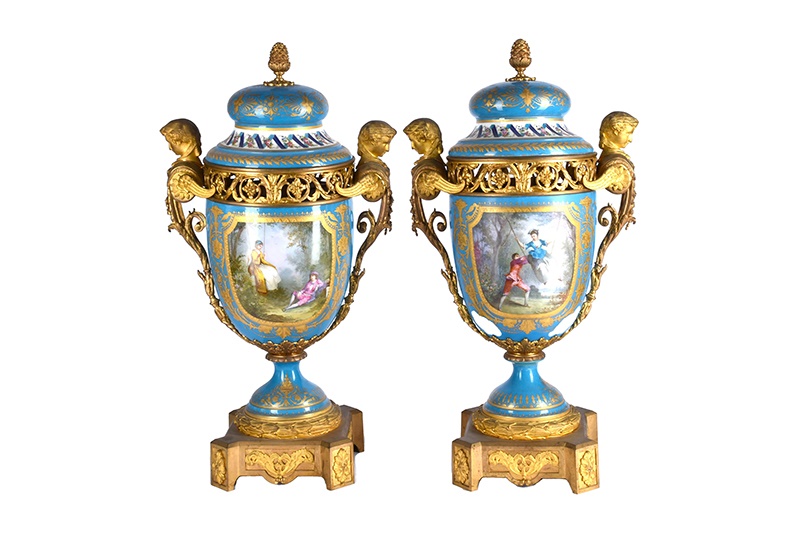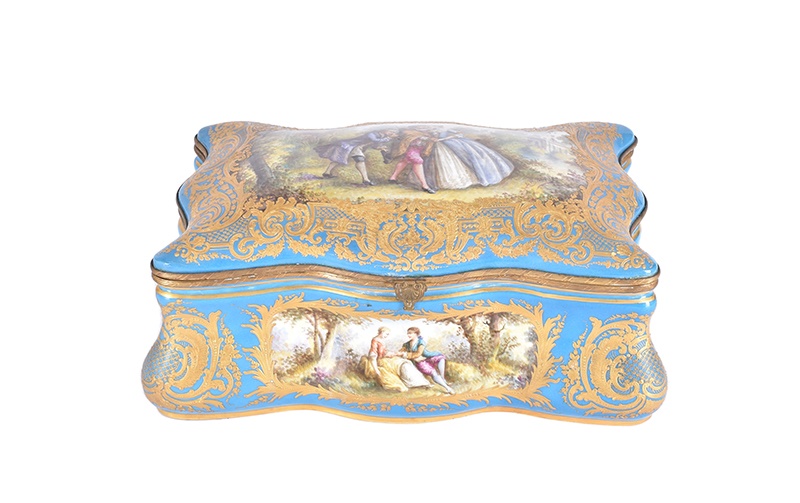How to Identify Sèvres Porcelain
Each era of Sèvres porcelain has its own distinctive style
11/03/2024
In the 18th century porcelain was highly desired throughout the world, and only the wealthy could afford this fragile extravagance which had to be shipped from the Far East at great expense, affording it the nickname “white gold”.
Whilst most Sèvres porcelain features a blue interlaced double-L marking enclosing a letter or two representing the date, and possibly a maker’s mark too, it is essential to be aware that this style was frequently copied, and marks forged throughout the 19th century. Cheap forgeries will have some obvious flaws, such as the quality of the painting and gilding, to the evenness of the glaze, but better-quality fakes do exist and can be mistaken for a genuine piece. To gain a better knowledge of Sèvres porcelain and the styles produced it is worth understanding the timeline of historical trends.
A collection of 18th century and later Sevres Bleu Celeste
In 1708, Potter Ehrenfried Walther von Tschirnhaus together with Alchemist Johann Friedrich Böttger uncovered the secret to making hard-paste porcelain, a recipe closely guarded by Japan and China for thousands of years. This would be the beginning of the Meissen domination as well as the launch of European porcelain production.
Eager to follow Germany’s success, France’s King Louis XV and his mistress, Madame de Pompadour, financed soft-paste manufacturer Vincennes and appointed them ‘manufacture royale’ in 1738. Initially taking inspiration from Meissen in their designs, they began to develop their own unique forms and decoration by the 1750s, with colourful grounds and detailed gilding. In these early days the factory became well known for their Rococo style with distinctive mottled “bleu lapis” grounds, as well as the very costly “bleu celeste” (“heavenly/sky blue”) colour which Louis XV famously requested for an entire service. Designs were inspired by natural forms and often featured birds and floral decoration. As the factory grew and flourished, it was eventually moved to the town of Sèvres in 1756, coincidentally located closer to Madame de Pompadour’s chateau, where it continues to produce porcelain to this day. The factory also worked with furniture makers who incorporated their plaques into designs.
 A large pair of Sevres ormolu mounted pedestal vases and covers
A large pair of Sevres ormolu mounted pedestal vases and covers
Until 1780 Sèvres was granted total monopoly in France for painting porcelain in more than one colour, pieces produced during this century are distinctive for the use of bright and vivid pinks, yellows, and greens, together with gold, white and naturally, blue. In 1763 they invented a new shade of blue, “beau bleu” or “bleu nouveau” which is commonly known today as “Sevres Blue”. During this time, they began developing a Neo-Classical style, which peaked during the reign of Emperor Napoleon I. As great admirer of Sèvres, Napoleon’s love of Ancient Greek and Egyptian design was a driving force at the factory.
The discovery of a deposit of the mineral kaolin in 1769 in Saint-Yrieix, led Sèvres to become the second manufacturer in Europe to produce hard-paste porcelain. This new material allowed for the introduction of new types of gilding and ground colours.
As Louis XV had taken over ownership of the factory in 1759, the abolition of the monarchy during the French Revolution resulted in Sèvres becoming the property of the French government. Despite the financial hardships during the turmoil, the factory continued and emerged at the start of the 19th century as the most highly regarded porcelain manufacturer in Europe. The focus shifted to the development of new glazes and colours, simulating hardstones, and marble, as well as more complex forms, such as intricate pierced bodies.
A large Sevres style porcelain bombe casket
By the mid-1800s Sèvres started experimenting with the neo-Gothic and Art Nouveau styles. They developed a technique called “pâte-sur-pâte” which involved building up layers of liquid clay in white onto coloured grounds. Advances in technology towards the end of the century together with new kilns allowed Sèvres to produce much larger, monumental wares than ever before. The factory has continued to produce throughout the 20thcentury developing their own modern designs reflective of this period.
While each era of Sèvres porcelain has its own distinctive style, the vibrant coloured grounds together with painted scenes and cartouches can also provide valuable insight. The most popular decorations include courting scenes, landscapes, depictions of mythology, fruits, military and maritime scenes, hunting, animals, birds, and flowers.
read more
How to Identify Antique Pottery
Are you considering selling any Sèvres porcelain?
With a huge global audience of potential buyers, Dawsons can help secure the best prices at auction.
Get in touch with an expert Valuer today for confidential sales advice, we would be delighted to help you:

